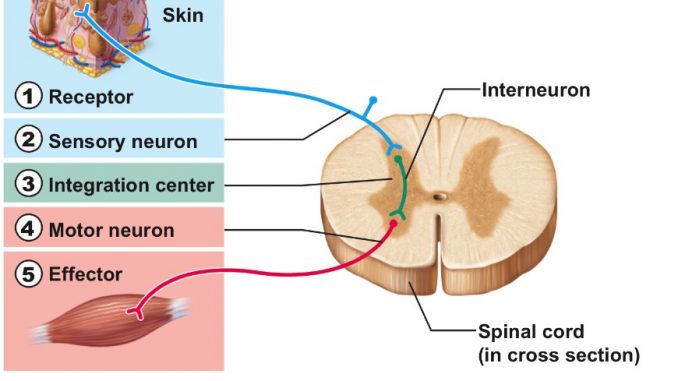
- An immediate or spontaneous response or reaction shown towards any stimulus by an organism is called reflex action.
- A reflex is a predictable involuntary response to a stimulus.
- g. watering of mouth at the sight of tasty food, immediate withdrawal of the hand after touching a hot object, blinking of the eye in response to a foreign particle that enters the eye etc.
- A reflex involving the skeletal muscles is called somatic reflex and that involving responses of smooth muscles, cardiac muscles or a gland is called visceral reflex.
- Visceral reflexes influence the heart rate, respiratory rate, digestion etc.
- The reflex action is controlled and coordinated by our spinal cord without the involvement of the brain. i. e. in addition to linking the brain and most of the body, our spinal cord coordinates the reflex action.
- Both types of reflex actions allow the body to respond quickly to internal and external changes in order to maintain our body activities and homeostasis.
- It takes milliseconds for the response to be shown during a reflex action.
- Reflex actions save time because the message being transmitted by the nerve impulse doesn’t have to travel from the stimulated receptor all the way to the brain.
Reflex arc:

https://www.quora.com/What-is-reflex-action
- A complete or entire pathway followed by the sensory and motor impulses during a reflex action is called a reflex arc.
- The major components and pathway of a reflex arc are as follows:
- Receptor (sensory organ): It receives a stimulus which then produces an electrical signal called nerve impulse.
- Sensory nerve (afferent nerve): It coveys or carries the impulse from the receptor organs to the dorsal root ganglion of the spinal nerve.
- The ganglia fibers then carry the impulse to the posterior horn of the spinal cord.
- Relay neuron (inter-neuron): The impulse from posterior horn of spinal cord is then transmitted to the anterior horn of the spinal cord via inter-neuron or relay neuron. This impulse may directly be passed without relay neuron as well.
- Motor nerve (efferent nerve): The motor nerve now receives the impulse from the anterior horn and transmits it to the effector organs or motor organs.
- Effector (motor organs): These are the organs that carry out the final action like voluntary muscle contraction and glandular secretion.